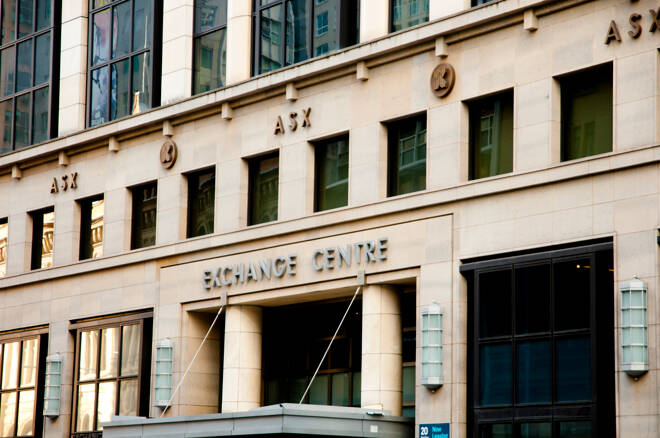Advertisement
Advertisement
ASX200: Weekly Wrap – 19/11/2021
By:
It was another bearish week for the ASX200, with the big-4 banks and commodity stocks pulling the index into the red.
Economic Calendar
Wednesday, 24th November
Construction Work Done (QoQ) (Q3)
Thursday, 25th November
Private New Capital Expenditure (QoQ) (Q3)
Friday, 26th November
Retail Sales (MoM) (Oct)
The ASX200
It was another bearish week for the ASX200, which fell by 0.62% in the week ending 19th November. In the week prior, the ASX200 had fallen by 0.19%.
Better than expected economic data from China delivered support at the start of the week before a pullback mid-week.
In October, fixed asset investments rose by 6.1%, year-on-year, which was down from 7.3% in September. Economists had forecast a 6.2% rise. China’s unemployment rate held steady at 4.9% in October.
Of greater significance, however, were industrial production figures.
In October, industrial production rose by 3.5%, year-on-year, which was up from 3.1% in September. Economists had forecast a 3.0% increase.
From Australia wage growth figures and the RBA’s monetary policy meeting minutes were also positives for the ASX200.
Inflation jitters and rising concerns over net interest margins for the big-4 banks pulled the majors into the red, however.
The Stats
In the 3rd quarter, wages grew by 0.6% quarter-on-quarter versus a forecasted 0.5% increase. Wages had grown by 0.4% in the previous quarter. Year-on-year, wages grew by 2.2%.
According to the ABS,
- Private sector wages rose by 2.4% annually, while growth in the public sector continued to track below the private sector.
- The annual growth rate returned to a more regular September quarter pattern of wage growth, following the labor market disruptions through 2020 and 2021.
Monetary Policy
Salient points from the RBA meeting minutes included:
- Outbreaks of the Delta variant led to a sharp contraction in the Australian economy in the September quarter.
- This delayed, but not derailed, the economic recovery that has been under way since the first half of the year.
- By mid-2022, activity was expected to be broadly in line with the pre-Delta recovery path.
- Household consumption was expected to underpin output growth in subsequent quarters as restrictions are eased.
- Inflation in the September quarter had been about 0.25 percentage points higher than expected 3-months earlier.
- Members noted that, in the central scenario, underlying inflation was expected to pick up gradually towards the end of the forecast period.
- While the forecast for inflation was higher than previously, members noted that the outlook for inflation in Australia differed from that for many other advanced economies.
- Members agreed, however, that the distribution of possible outcomes for inflation had widened.
- Two alternative scenarios in light of the considerable ongoing uncertainty around health outcomes and household consumption were considered.
- A stronger economic trajectory than the central scenario was possible if households increased spending by more than expected.
- A weaker trajectory could stem from precautionary saving, alongside possible adverse health outcomes, such as the emergence of a new COVID-19 variant or waning efficacy of vaccines in H12022.
- Members acknowledged that the risks to the inflation forecast had changed.
- The main uncertainties related to the persistence of current disruptions to global supply chains and to the behavior of wages at the lowest unemployment rate in decades.
From Elsewhere
Upbeat retail sales figures from the U.S together with a pickup in manufacturing sector activity in NY State and Philly were also market positive.
In October, both retail sales and core retail sales increased by 1.7%, coming in ahead of forecasts.
The NY Empire State Manufacturing Index rose from 19.8 to 30.9, with the Philly FED Manufacturing PMI increasing from 23.8 to 39.0.
The Market Movers
It was a mixed week for the banks. Commonwealth Bank of Australia slid by 9.54% to lead the way down. While quarter earnings were upbeat, a warning over net interest margins weighed heavily.
ANZ (-3.40%), NAB (-4.35%), and Westpac (-2.42%) also struggled.
Macquarie Group bucked the trend, however, rising by 3.35%.
Commodity stocks also had a bearish week. Rio Tinto and BHP Group ended the week down by 2.13% and by 3.32% respectively. Fortescue Metals Group Ltd and Newcrest Mining saw relatively modest losses of 1.78% and 1.70% respectively, however.
Other Asian Markets
Elsewhere, it was a mixed week. The Hang Seng Index fell by 1.10%, while the Nikkei 225 and the CSI300 ended the week up by 0.46% and by 0.03% respectively.
The Week Ahead
It’s a busier week ahead on the Asian economic calendar. From Australia, economic data includes construction work down and private new CAPEX figures ahead of retail sales data on Friday.
Expect the retail sales figures to be key.
From elsewhere, private sector PMIs from the U.S and Europe, together with 3rd quarter GDP numbers for the U.S and Germany will also influence.
Away from the economic calendar, commodity prices will remain a key driver, however, with COVID-19 news updates also likely to influence.
About the Author
Bob Masonauthor
With over 28 years of experience in the financial industry, Bob has worked with various global rating agencies and multinational banks. Currently he is covering currencies, commodities, alternative asset classes and global equities, focusing mostly on European and Asian markets.
Advertisement
